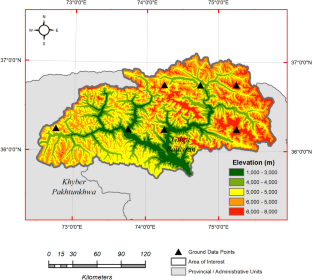Environmental Earth Sciences ( IF 2.8 ) Pub Date : 2024-04-10 , DOI: 10.1007/s12665-024-11571-9 Muhammad Shareef Shazil , Syed Amer Mahmood , Sheharyar Ahmad , Muhammad Haseeb , Amer Masood , Jahanzeb Qureshi , Saira Batool

|
The Upper Indus Basin (UIB) is a major water resource for Pakistan, and recent years have seen it profoundly affected by climate change, resulting in catastrophic events. Analyzing climatic patterns in UIB and its sub-basins is vital for sustainable water resource management. This research delves into the precipitation and temperature trends within the Gilgit and Hunza River basins (sub-basins of UIB) from 1980 to 2019, utilizing an extensive dataset comprising ground station records and global climate datasets such as CRU and ERA 5. Our findings indicate a notable increase in temperatures, particularly pronounced in the Hunza basin compared to Gilgit. Conversely, precipitation trends reveal a predominant decrease. Employing validation techniques, we confirmed that ERA 5 surpassed CRU in providing accurate temperature and precipitation data. Employing methods including the Mann–Kendall, Sen's slope, and Abrupt Change Point Tests, we identified temperature increases of 0.21 °C and 0.25 °C per decade. Additionally, CRU assessments unveiled a decline in diurnal temperature. Seasonal analysis showcased significant temperature rises during summer, autumn, and spring, while winter conditions remained consistently stable. Our analysis also pointed to slight increases in summer precipitation, with winters exhibiting heightened wetness according to the CRU datasets. Continual monitoring of the Upper Indus Basin (UIB) is imperative for enhancing precision and reliability. This proactive approach, complemented by meticulous spatiotemporal analysis, will establish a robust foundation for comprehending and addressing climate changes in the region.
中文翻译:

评估吉尔吉特和罕萨河流域温度和降水的长期变化和趋势
印度河上游盆地(UIB)是巴基斯坦的主要水资源,近年来深受气候变化影响,导致灾难性事件发生。分析 UIB 及其子流域的气候模式对于可持续水资源管理至关重要。这项研究利用包括地面站记录和全球气候数据集(例如 CRU 和 ERA 5)的广泛数据集,深入研究了 1980 年至 2019 年吉尔吉特和罕萨河流域(UIB 的子流域)内的降水和温度趋势。我们的研究结果表明与吉尔吉特相比,气温显着升高,尤其是罕萨盆地。相反,降水趋势显示主要减少。采用验证技术,我们确认 ERA 5 在提供准确的温度和降水数据方面优于 CRU。采用曼-肯德尔、森斜率和突变点测试等方法,我们发现温度每十年增加 0.21 °C 和 0.25 °C。此外,CRU 的评估显示昼夜温度有所下降。季节性分析显示夏季、秋季和春季气温显着上升,而冬季条件始终保持稳定。我们的分析还指出,根据 CRU 数据集,夏季降水略有增加,而冬季则表现出较高的湿度。对印度河上游盆地 (UIB) 的持续监测对于提高精度和可靠性至关重要。这种积极主动的方法辅以细致的时空分析,将为理解和应对该地区的气候变化奠定坚实的基础。



























 京公网安备 11010802027423号
京公网安备 11010802027423号